


3rd Battalion, 20th Engineers
The Third Battalion
Note: Most of the text of this article comes from "TWENTIETH ENGINEERS -- FRANCE -- 1917-1918-1919"
The nucleus of our Third Battalion began to form from early in October, 1917, as a casual Company attached to Regimental Headquarters. The Battalion organization was authorized October 13, and for the ensuing month recruits were arriving daily. Long before the unit reached its authorized strength it became apparent that the First and Second Battalions could not embark as early as scheduled, owing to lack of equipment and the congested condition of Camp American University mat the finding of other training quarters for the new unit.
On October 28, the Battalion, now half up to war strength, emigrated to Belvoir, a quiet little R. O. T. C. camp on the Virginia side of the Potomac twenty miles below Washington. A month of drill, larded with camp-building details, followed. November 19 the Third Battalion was split in twain, 165 officers returning to Washington as a skeleton Fourth Battalion. For the next few days recruits swarmed in, and by Thanksgiving Day the Third was at strength.
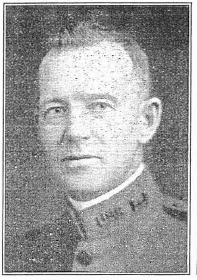
Major A. W. Corkins, commanding officer of 3rd Battalion, 20th Engineers
Click the image for an article that includes info on the 3rd Battalion
Two weeks later the outfit, having outgrown the Belvoir environment, moved to Fort Myer, Va., six miles south of Washington, where training and equipping were completed. This chapter in the history of the outfit can well be told in one word: Quarantine. If it wasn't one thing it was another. Mumps, measles and scarlet fever took their course. But one event stands out in this period; the review of the Third and Fourth Battalions by the Secretary of War, December 15. The column, led by the Fourth Band, paraded Pennsylvania Avenue, retracing part of the route of the huge procession of the Union 1865, and were reviewed from the portico of the War Department Building.
The training period of the Battalion ended abruptly with the coming of 1918. Midnight of January 2 saw the column under way, on a nine mile hike through the snow, under full pack and silence orders. The troop - train was parked at the most distant trackage available, and was entirely unheated; but it was there on schedule. Jersey City was reached at 3 the next afternoon, and the Third, here joined by the Fourth Battalion, were lightered upstream to Hoboken. By 10 P. M. the companies stumbled up the gangplank of U. S. S. "America,'' a converted Hamburg American liner of 21,000 tons.
The next afternoon the transport started down the harbor, with all troops strictly below decks as a precautionary measure. "Join the Navy and see the world from a porthole,'' but even the portholes were out of bounds for the enlisted men, who had to forego the inspiration of waving farewell to the Goddess of Liberty under the repeated urge of Call to Quarters.
The convoy, assembled during the night off Sandy Hook, consisted of the transports "America" and "Mercury,'' and the cruiser "Seattle.'' Apart from the one big thrill of going Over, and the tedious round of Abandon Ship drill, several events of the voyage are memorable. In mid ocean the ''Seattle'' rescued the crew. of a waterlogged and dismasted lumber schooner. The afternoon of the 14th the wireless gave word of submarine activity ahead, and the convoy, turning on a fixed pivot, executed a strategic flanking movement.
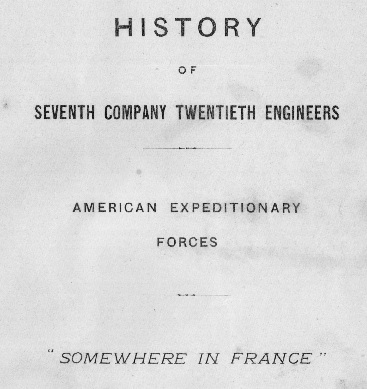
A great history of Company A, 3rd Battalion, 20th Engineers
Includes troop roster and addresses
Caution - very large pdf download
Early on the morning of the 17th of January, 1918, came the big thrill. Lookouts sighted a torpedo wake heading for the "America,'' but the deadly missile missed the stern of the ship, by the narrow margin of twenty feet. The submarine was never sighted. Three hours later land was sighted, and at noon the ship dropped anchor in the roadstead at Brest. Three days later the Battalion was lightered ashore, and marched through Brest to Pontenzen Barracks, recently taken over from the French.
After five days of rest, consisting of close order drill, route marches, fatigue and, for the last four days, food, the Battalion entrained for their permanent stations, the three companies and headquarters separating for the duration, as they left the Brest station.
Company A, later the Seventh Co., accompanied Battalion Headquarters to historic Dijon. Here they were split into three detachments. Company headquarters were sent to Mirebeau, the First Det. to Vitteaux, and the Second to Montbard, all in the Dept. of Cote d'Or.
The Nirebeau unit started operations with a French portable mill, replacing with a 10M American mill in March. The First Det. took over the operation August 18, and Headquarters Det. was moved to the village of Velet, on the Saone River. Logging commenced with the customary speed, but the mill was still un-completed when the Armistice stopped the program. Logging and fuel production continued till the end of March, 1919, the abortive homecoming orders of January 15 making no the routine of production and shipment.
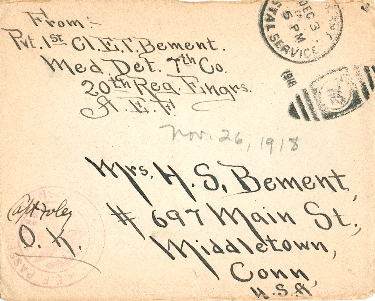
A letter from Pvt. 1st Cl. E. T. Bement to his mother
Bement was assigned to the Medical Detachment of 7th Company
The First Detachment drew a difficult operation in oak and spruce at Saffres, near Vitteaux. A French Portable ran day and night until the finish in August. The Saffres job ranked low in production owing to scanty stands and unskilled direction; but the celerity with which the outfit cleaned up the Mirebeau operation proved that the fault was not in personnel. The next task was at Beze, where logging was in full swing till after the Armistice.
The Second Detachment was of brief duration. Three months of logging, with primitive equipment, and the Montbard Camp was turned over to colored service troops, the Seventh Co. men being divided between the Vitteaux and Mirebeau operations.
The company was reunited at Velet and on March 30 joined the Ninth Co. at Gray, for the trip to the Dax embarkation area.
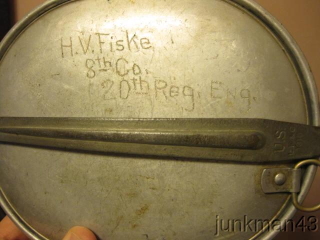
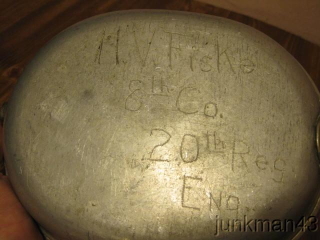
Mess Kit belonging to H. V. Fiske, 8th Company (Company B, 3rd Battalion), 20th Engineers
Company B entrained at Brest, noon, January 25, 1918 and sped eastward to the Haute Marne region, where they joined Co. E of the Second Battalion on the St. Dizier operation. A consolidated mill was built with two saw rigs, each of 20,000 feet rated capacity. The timber available was more extensive than at most of our developments, and the force was augmented by the addition of several service detachments.
The camp was only some twenty five miles from the front, during the summer of 1918, and more than once the mill came under hostile air-raids. One night a well intentioned bomb tore up the baseball diamond a few rods from camp but at no time were casualties incurred. The proximity led to one of the most frequent infractions of regulations Forestry troops in the advance zone—A. W. O. L. excursions to the front. One member of the Eighth Co. managed to attach himself to the Second Division, and clung to his adopted organization until put out of action on the Vesle front.


Photos of Pvt Scott McLellan Hill, Saddler, 8th Company, 20th Engineers
In the group photo, Hill is in the back row, second from the left.
Also in the group photo is Pvt Frank Campbell, first row, fourth from left.
The two were neighbors and worked with horses and mules in civilian life.
Photos are contributed by Louis Gansell, great-grandson of Hill.
According to Gansell's Great Aunt Irene, Hill was gassed and lay on the field
of battle incapacitated and a wagon ran over his legs and crushed them.
Hill wore braces on his legs the rest of his life and was lame.
Click on the photos for larger sizes and to see the writing on the back.
Several small detachments from St. Dizier were sent to join the 15th and 38th Co.s in the First Army area in October, equipped with portable bolter mills for emergency cutting in newly won territory. They rejoined the outfit early in December.
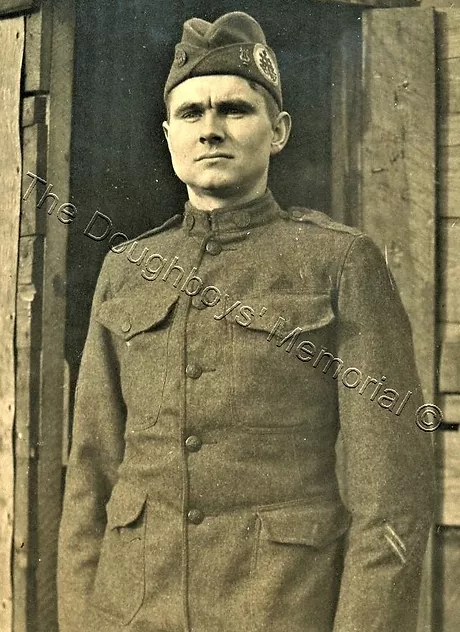
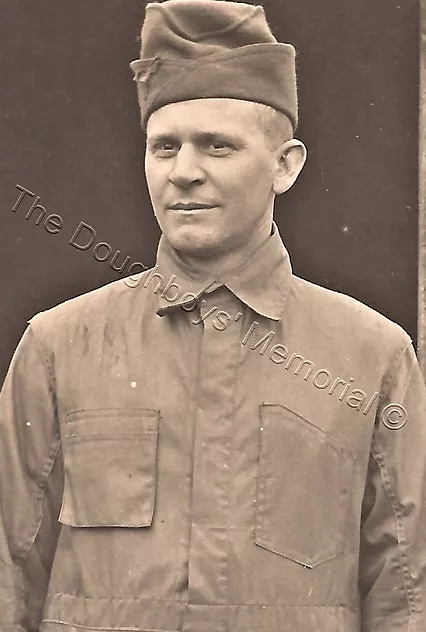
Private (Musician) Calvin H Albitz -- Sergeant Joseph W Norris
Both of 8th Company
About the first of April, 1919, the 8th Co. was ordered to the embarkation area formed for Forestry troops at Dax, in the Landes. They arrived at Mees, the former home of the 1st Co., but were soon moved to Arengosse, twenty five miles to the north, where preliminaries for embarkation were completed. May 8th they boarded cars for Bordeaux, and were added to the train bearing the rest of the Third, and two companies of the Fourth Battalion, to Bordeaux.
Co. C drew a hardwood operation at Sauvigney les Gray, in the upper valley of the Saone, and under the Dijon administration. The timber available was scattering, and the long hauls to the mill led to the adoption of narrow-gauge logging railways. A standard gauge spur was run to the millsite, and the products, chiefly ties and dimension, loaded direct for the area of active operations.
Post Armistice activities included heavy fuel production. In March the camp work was completed. On the 30th the Seventh C,o. joined the Ninth at Sauvigney, and after a farewell parade through the town the units entrained for Dax, where they were billeted in the old First Battalion camps.
The morning of May 9th, the Seventh and Ninth Co.s, with Third Battalion Headquarters and the Third Detachment, entrained, in company with the Fourth Battalion Headquarters, the Eleventh, and Twenty third Co.s. The Eighth Co. was picked up on the way, as was the Twelfth, and the contingent pulled into Bordeaux at 11 P. M. Although a station two miles from the embarkation camp was available, the Battalions were detrained at Gare St. Jean, the principal depot of Bordeaux, and marched under full equipment and overcoats, to Genicourt.

Soldiers of 3rd Battalion aboard the Zeelandia--Going Home!
The next day the outfits passed through the mill, which has been recognized as much more thorough and wearing than the like institutions at Brest, and St. Nazaire. That evening orders were issued for the embarkation of the Fourth Battalion, and the Eighth and Ninth Co.s of the Third. They hiked to morning of the 11th, walked the gangplank at noon and sailed at 2 P.M. aboard the converted Holland American "Zeelandia."
The crossing was smooth—to a sailor—but to of seventeen months of wholesale Army rations the general loss of appetite was astonishing. The transport docked at Newport News, Va., May 23rd, and the last detachments were on their way to home camps a week later.
Third Battalion Headquarters and the Seventh Co. were held at Genicourt three days longer. May 14th they sailed in company with the Sixth Battalion, on the Santa Paula; they landed at New York May 28th and were disbanded at Camp Merrit.
Officers of 3rd Battalion, 20th Engineers:
Battalion Commander - Major Arthur W. Corkins
Engineer Officer - Captain Winthrop H. Estabrook
Adjutant - Captain Oliver J. Todd
Supply Officer - First Lieutenant Charles Jenkins
Company A
Company Commander - Captain Collin E. Clark
First Lieutenants - Harold M. Power, Jay H. Price and E. B. Hamilton
Second Lieutenants - Earl B. Birmingham and Albert L. Shellworth
Company B
Company Commander - Captain Earle P. Dudley
First Lieutenants - Herbert L. Holderman, Alexander H. Ellison and Morton Van Meter
Second Lieutenant - Fayette L. Thompson
Company C
Company Commander - Captain George G. Steel
First Lieutenants - Clement C. Abbott, Frederick B. Judge and Fred A Stone
Second Lieutenant - Charles J. Davis
Medical Detachment
Battalion Surgeon - Captain Frederick C. Moor, M. R. C.
First Lieutenants - Harold T. Antrim, M. R. C., and Edward S. Bracken, Jr., D. R. C.